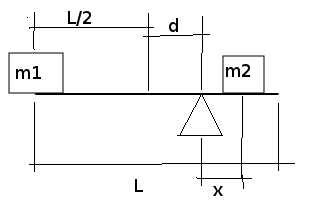Exam excercise 3, 2017-01-13
Two boxes, \(m_{1}\) and \(m_{2}\), rests on a beam in balance.
Known values:
beam_M = 1.0 # mass
m1 = 2.0 # mass
m2 = 5.0 # mass
d = 0.75 # length
beam_L = 5.0 # length
two = 2.0 # one
g = 9.0 # acceleration
Direct implication:
We want to be able to represenet the torques.
A torque (sv. vridmoment) is defined as:
\[ \tau = distance\ from\ turning\ point \cdot force \]
\[ \tau = distance\ from\ turning\ point \cdot mass \cdot gravitation \]
To get the beams torque on one side, we need to divide by 2 because the beam’s torque is spread out linearly (the density of the beam is equal everywhere), which means the left parts mass centre is \(half\ the\ distance\) of the left parts total length.
\[ beamL_{\tau} = beamL_{M} \cdot gravity \cdot \frac{beam\ left\ length}{2} \]
where
\[ beamL_{M} = \frac{beam\ left\ length}{beam\ length} \cdot beam_M \]
We make an expression for \(m2_{\tau}\), which involves our unknown distance x.
\[ m2_{\tau} = m2 \cdot gravitation \cdot x \]
For the teeter to be in balance, both sides torques should be equal.
\[ Left\ side\ torque = Right\ side\ angular\ torque \]
We try to break out \(m2_{\tau}\) and then x.
\[ m1_{\tau} + beamL_{\tau} = m2_{\tau} + beamR_{\tau} \]
\[ m1_{\tau} + beamL_{\tau} - beamR_{\tau} = m2_{\tau} \]
\[ the\ distance\ x = \frac{m2_{\tau}}{m2 \cdot gravitation} \]
Our solution:
Security check:
We can control that both sides total torque are equal, and that the dimensions of \(x\) is a length.